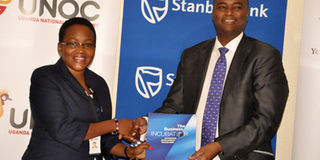Pain from oil and gas is behind us - Stanbic boss

Uganda National Oil Company chief executive officer Proscovia Nabbanja shakes hands with Stanbic chief executive Patrick Mweheire after signing a Memorandum of Understanding to promote national content last week. COURTESY PHOTO
What you need to know:
- Prosper’s Christine Kasemiire caught up with the bank’s chief executive officer, Patrick Mweheire on what this portends. Here are the excerpts:
What exactly does this partnership between Stanbic bank and Uganda National Oil Company signify to the public?
During development, we are looking at between 13,000 to 14,000 people directly employed within one geographical region. That means that they have to eat.
We thought that by intervening in areas such as agriculture, it is crucial for people like the women, youth and the uneducated to get involved in the oil and gas sector. We think that this partnership with UNOC will keep Ugandan companies abreast in terms of timelines and what we should expect.
It will also bring in industry experts who are currently practising to train the companies in crucial areas such as health, safety and environment among others.
Which businesses qualify to take advantage of these opportunities?
To be a part of the Business incubator programme, you ought to be a registered business, have practiced for at least a year. But you need not be a customer of Stanbic bank.
You have had training since talks of oil started; how have these progressed?
We have been at this for two years and trained almost 1,500 individuals. We have invested heavily over the years. I can say we have spent close to $5m (Shs18.3b) in training Small and Medium Enterprises (SME) and are actually spinning this incubator out of the bank.
As of the next quarter, the SME incubator is going to be a standalone subsidiary out of the bank. It is going to get and receive funding from many other third party sources as well as partnerships.
Clearly, Stanbic has positioned itself to take advantage of the oil and gas sector. But with the delays in the Final Investment Decision, what now informs the bank’s optimism yet activities in the sector have stalled?
It is true, everything rests on FID. It opens the gates for the real contracts to be signed, which has not happened. I think there is some optimism, there is still a window that it might happen this quarter or early next quarter. That is really the trigger for everything. We are still optimistic and I know that conversations are happening between the stakeholders to try and get to FID.
Yes, some banks took a bit of hits because of lending to some sectors on the premise that FID was coming and it did not. But the truth of the matter is many of the things can be deployed to other sectors.
I do not think it is a complete wash, because if you had a truck that was designed to participate in oil and gas, it is still an asset. There is still a lot of logistic equipment that is moved from Mombasa and Uganda, particularly in infrastructure as government continues to spend on infrastructure. But we are still very optimistic that once we get FID, we shall be looking for more investment.
Rewinding to the inception of the oil and gas buzz in Uganda, how much of Stanbic bank’s loan portfolio is tied to this sector?
About 20 per cent of our loan book is in oil and gas and it is significant. However, it is downstream. So it is with Total, Vivo and Mogas. It is a significant part of our portfolio and it is performing. Of course, we had a few names that got hurt by investing early and losing some money but it was not significant.
But as a bank dealing with customer deposits, doesn’t this pose a threat to your balance sheet?
We have worked with these companies. We have just restructured many of them [loans] and tried to buy them time to get back into the game. I do not think you can abandon clients because they are going through some difficult period.
FID delays go back five years, this is a long story. 2014 is where the pain started; we are in 2020 now, so the pain is behind us.




